Giving meaningful feedback on student writing is one of the most important parts of the learning process. When students receive clear, thoughtful responses to their work, they begin to understand the writing process in a much deeper way. Good feedback is more than a quick “good job” or a checkmark. It helps students grow as writers by pointing out specific strengths and identifying areas for improvement. Whether you’re marking a rough draft or reviewing a final product, effective teacher feedback should guide students toward their next step.

When responding to a text, like STAAR or extended constructed response questions, teacher feedback needs to do two things: recognize what students did well and help them write more clearly and effectively next time. These types of tasks require students to read closely, use text evidence, and explain their thinking. That means your feedback should focus on how well they understood the prompt, used evidence, and organized their response.
HOw to Write Effective Feedback
To write effective feedback, teachers need to:
- Focus on specific skills such as sentence structure, word choice, and organization
- Use language that encourages a growth mindset
- Offer both praise and suggestions
- Keep comments focused and manageable
- Align feedback with grade-level standards and goals
Formative assessments, especially during writing workshop or a writing conference, should be timely and personalized. They are a great time to offer actionable feedback. Instead of overwhelming students with too much feedback, choose 1-2 key points that matter most. For example, when reviewing a student’s writing, you might say: “You restated the question well. Next, try adding a strong answer to your topic sentence so the reader knows your main point right away.” The most effective feedback helps students see the purpose behind revisions and builds confidence in their own writing.
What Is an Example of Good Teacher Feedback for writing
When students write in response to text, your feedback should go beyond whether they got the right answer. A good idea is to provide specific feedback such as:
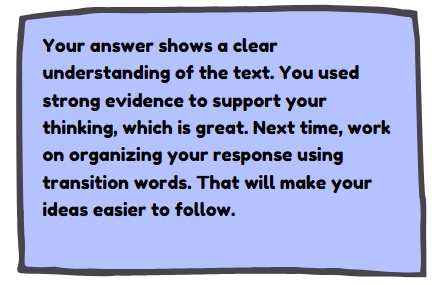
This kind of feedback is purposeful, supportive, and actionable. It highlights what the student did well, gives specific examples of what to improve, and connects to the writing process. In writing assignments where students are learning how to cite evidence or explain their thinking, comments like these reinforce the value of both content and structure.
Let’s break that down even further. For example, if a student restates the question and gives a partial answer, you could write:
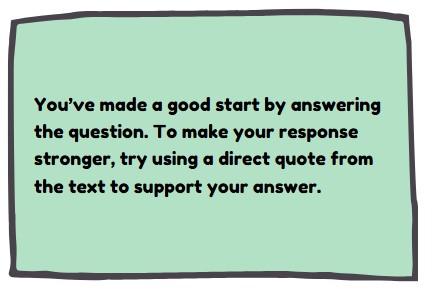
Or if a student explains a quote but forgets to connect it back to the prompt:
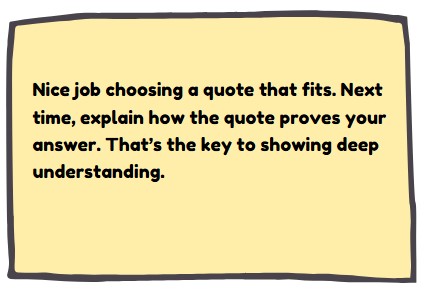
Teachers can also use writing checklists or feedback forms to help students self-assess and reflect on their growth. A simple end note might say: “You’re heading in the right direction. Let’s work on strengthening your conclusion in the second draft.” A teacher guide or quick-reference sheet for types of feedback and types of comments can help you stay consistent and efficient.
Grab this ready-to-use prep bundle with feedback forms, sentence stems, and comment templates to use across all your writing units. Download now.
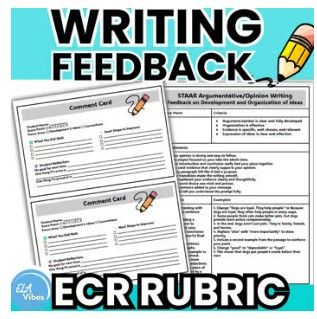
How to Give Positive Feedback on Student Writing
Positive feedback is more than just saying “great job.” It should highlight a specific area of the student’s work and explain why it’s effective. This encourages students to keep using those skills in future pieces of writing.
In STAAR-style extended responses, students are asked to do quite a bit: read carefully, identify key ideas, and write organized, well-developed responses. Positive comments help them feel like they’re not starting from scratch every time. Instead, they’re building on what they already know.
Here are a few examples:
- “Your response has a clear beginning, middle, and end. That helped me follow your thinking easily.”
- “Great use of text evidence. You picked a quote that really supports your answer.”
- “The way you explained your answer in your own words shows strong comprehension.”
Positive reinforcement can motivate students and help them become better writers. It also builds trust between the teacher and student, making them more open to constructive feedback later.
Try pairing every suggestion with a positive comment. For example: “I liked your word choice in this paragraph. You might also think about adding more detail to your final sentence.”
Constructive Feedback that moves students forward
Constructive feedback is about helping students grow. It focuses on what they can do next time, not just what went wrong. One of the most effective strategies is the “feedback sandwich”: start with something positive, offer a specific suggestion for improvement, and end with encouragement.
In a response to text task, constructive feedback should be grounded in what students wrote and how they supported it. Instead of saying, “Your response was confusing,” try:
“Your answer has good ideas, but it’s a bit hard to follow. Try using a clearer topic sentence and smoother transitions between examples.”
OR:
“You understood the main idea, but your quote doesn’t really prove your point. Reread the text to find a stronger piece of evidence. You’re almost there.”
Use directive comments that guide students to revise. For instance, say: “Add a clearer topic sentence here,” instead of “This paragraph is weak.”
This kind of feedback is especially helpful for peer groups, special education students, or English language learners. Clear language and a focus on one specific skill can keep feedback from feeling overwhelming. Sentence starters, visuals, or model paragraphs can also support students who need more structure. You can also provide model sentences in different formats (sticky notes, marginal comments, digital comments) to offer guidance.

Be Purposeful with Feedback
Feedback should not feel random. It should connect to a learning goal, writing standard, or individual student need. Before you leave comments, ask yourself:
- What is the most important thing I want this student to learn right now?
- What part of their writing shows growth?
- What is the best way to support their next step?
Consider the timing, too. Formative feedback during the rough draft stage can shape a student’s writing in meaningful ways. Summative feedback on a final draft should help them reflect on what they learned and how they can apply it in the future.
Response to Text Feedback
When giving feedback on a response to text, make sure your comments:
- Address the prompt directly
- Connect to the student’s use of text evidence
- Encourage clarity, organization, and development
- Use assessment language familiar to the student
Using peer feedback is also a great way to involve students in the revision process. Teach them how to give useful comment suggestions by modeling it and using feedback forms or sentence starters like:
- “One thing you did well was…”
- “One idea to try next time is…”
- “Have you thought about adding…?”
Peer feedback doesn’t replace teacher feedback, but it adds another layer. This keeps student learning collaborative and builds revision habits. It builds community and shows students how to talk about writing.
Frequently Asked Questions About STAAR Writing Feedback
When it comes to STAAR writing, especially extended constructed response tasks, teachers often have a lot of the same questions. These aren’t just technical. They shape how we guide students through the writing process. Below are a few of the most frequently asked questions, along with practical answers you can bring straight to your classroom.
How long should a STAAR extended response be?
There’s no magic number of sentences, but most effective responses fall between 150–200 words. That’s typically 1–2 focused paragraphs. What matters more than word count is whether students fully explain their thinking and back it up with strong, relevant evidence from the text.
What is the STAAR scoring rubric for writing?
The STAAR writing rubric evaluates two main areas: development and organization of ideas and conventions. Students earn higher scores when they clearly state a thesis, organize their ideas logically, support them with text evidence, and use appropriate conventions and vocabulary. Teaching students to write with this in mind helps align their drafts with what scorers are looking for.
How do you teach transition words in text response?
Start with small, focused mini-lessons. Teach different types of transitions (sequence, contrast, explanation) and give students sentence stems to practice. For example: “This shows…”, “In contrast…”, “Another example is…” Use modeling and color-coding strategies to highlight transitions in mentor texts or student exemplars. Anchor charts and editing checklists can help make transitions stick.
How do you model feedback for STAAR in writing workshop?
The best modeling is simple and authentic. Take a student example (with permission), project it, and think aloud while giving feedback. Say things like, “I really like how this sentence starts, but I’m wondering if it could use more support.” Use sentence starters for feedback and show how to leave comments in the margin or in Google Docs. The more you model, the more comfortable your students will get giving and receiving feedback too.
Grab this no-prep short and extended constructed response guide to walk students through the writing process.
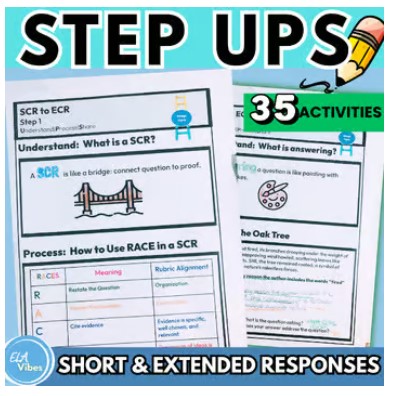
Conclusion: Giving Students Feedback That Matters
Giving effective feedback is one of the best ways to help students grow as writers, especially when it comes to response to text writing. Whether it’s a STAAR extended constructed response or a classroom writing prompt, your comments should help students understand what they did well and where they can go next. Keep it specific. Keep it actionable. And always connect it back to the writing process. Whether you’re using sticky notes, digital comments, or one-on-one conversations, focus on what matters: helping students move forward in their writing.
Additional Resources to Add to Your Toolbox

Favorite Amazon Items to Support Making Inferences
This post contains affiliate links, which means I may earn a small commission at no extra cost to you. I only share resources I truly love and use myself—thanks for supporting my corner of the teacher world!

